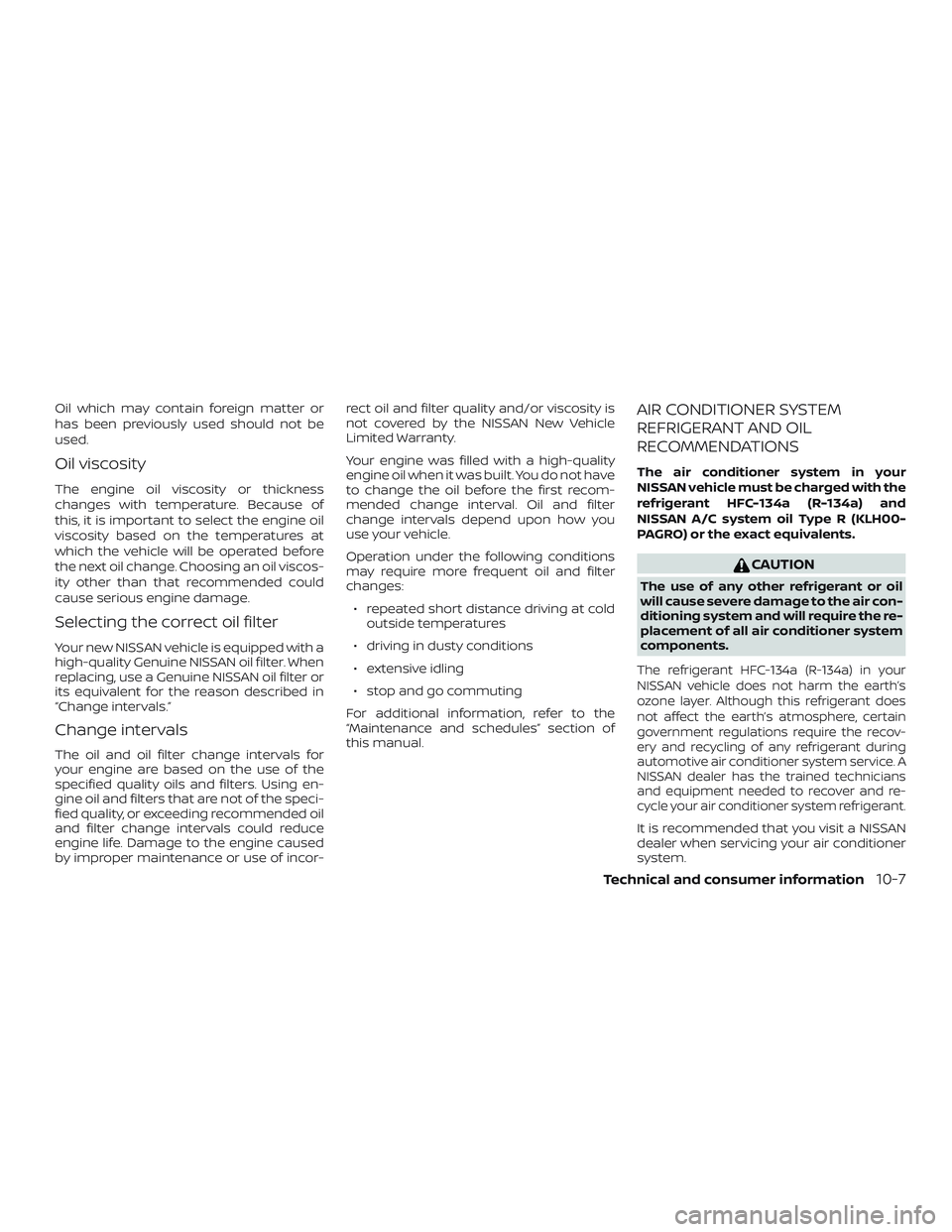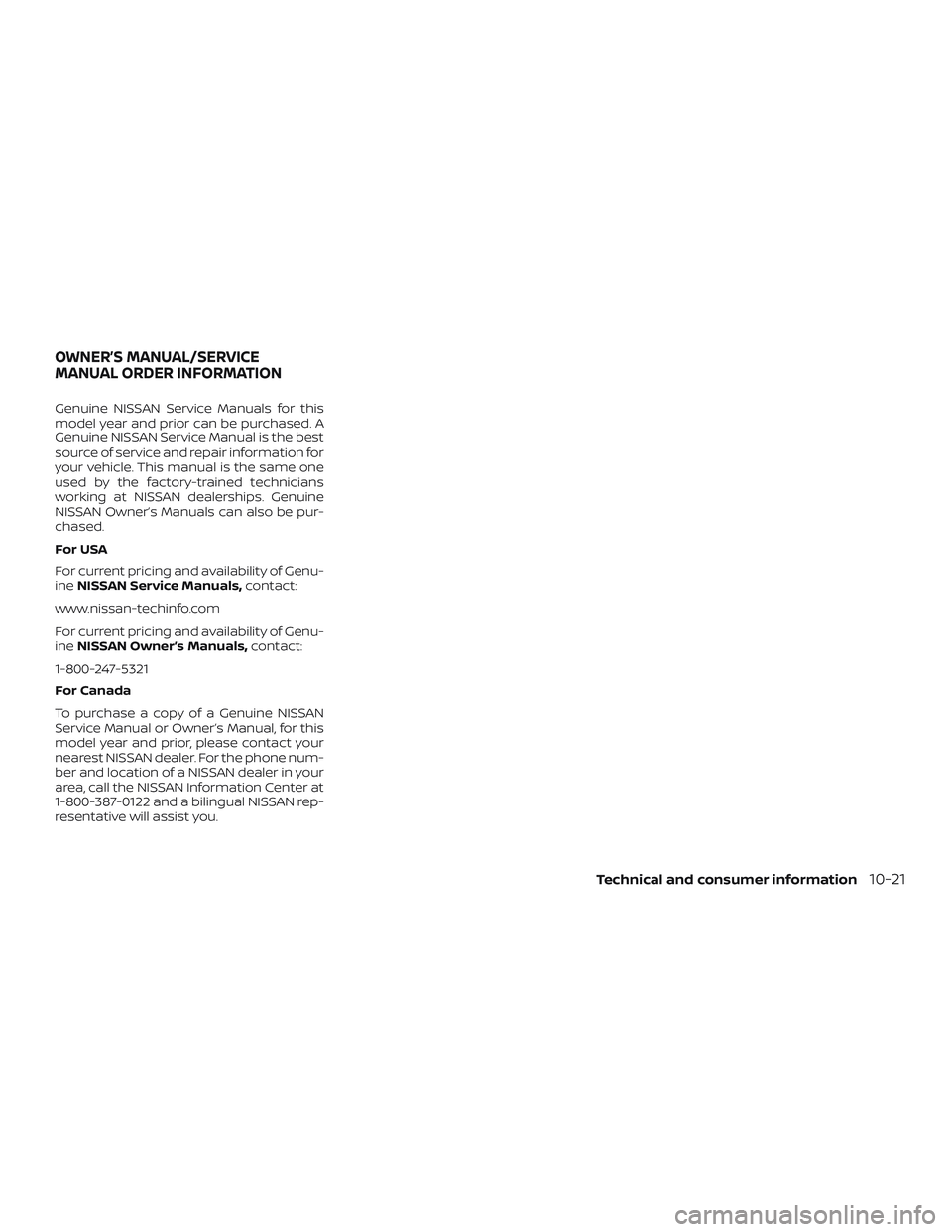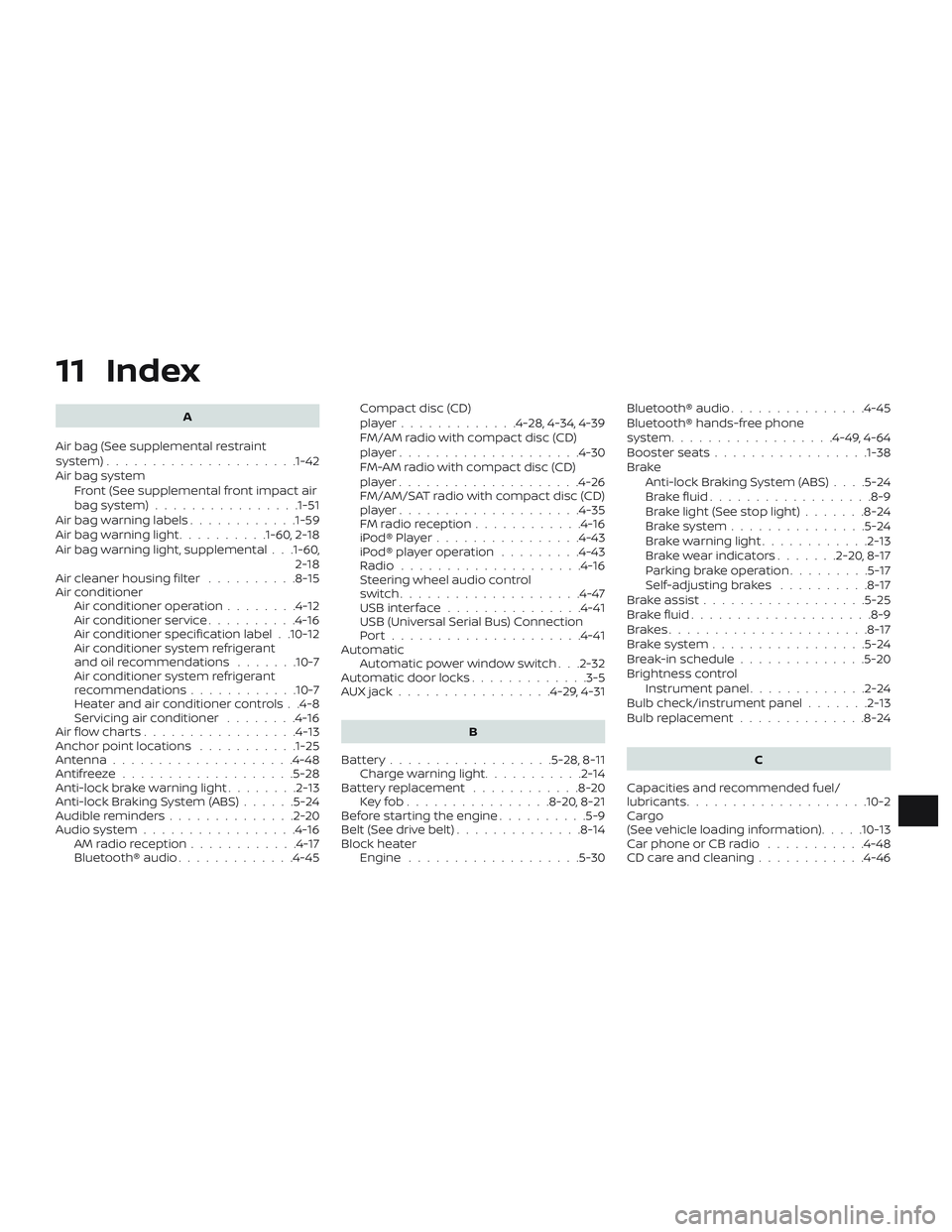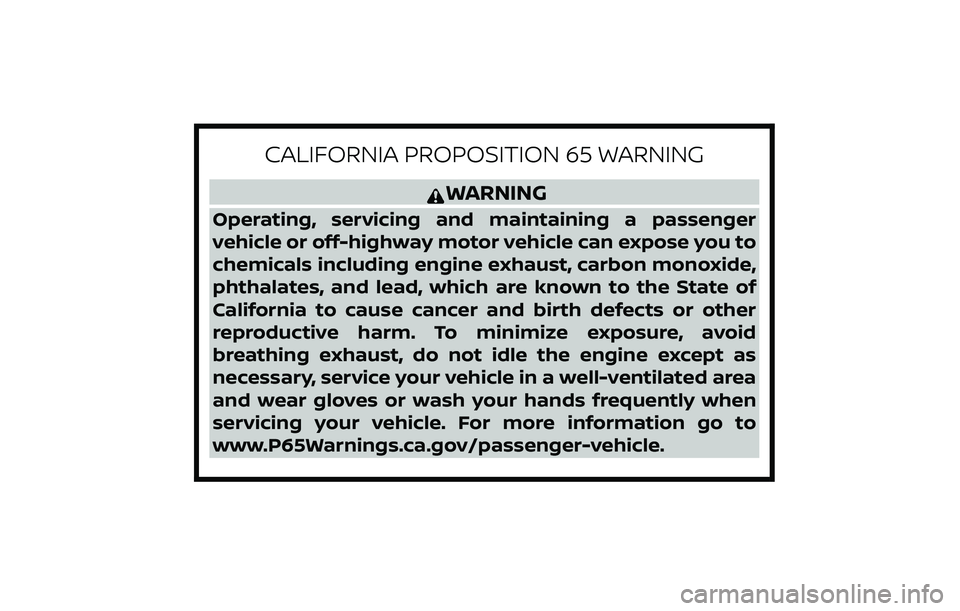2018 NISSAN VERSA SEDAN service
[x] Cancel search: servicePage 323 of 702

FUEL RECOMMENDATION
Use unleaded regular gasoline with an oc-
tane rating of at least 87 AKI (Anti-Knock
Index) number (Research octane number
91).
CAUTION
∙ Only vehicles with the E-85 filler door
label can operate on E-85. Fuel system
or other damage can occur if E-85 is
used in vehicles that are not designed
to run on E-85.
∙ Using a fuel other than that specified
could adversely affect the emission
control system, and may also affect
the warranty coverage.
∙ Under no circumstances should a
leaded gasoline be used, because this
will damage the three-way catalyst.∙ Do not use a fuel containing more
than 15% ethanol in your vehicle. Your
vehicle is not designed to run on a fuel
containing more than 15% ethanol.
Using a fuel containing more than 15%
ethanol in a vehicle not specifically
designed for a fuel containing more
than 15% ethanol can adversely affect
the emission control devices and sys-
tems of the vehicle. Damage caused
by such fuel is not covered by the
NISSAN New Vehicle Limited Warranty.
∙
Do not use fuel that contains the oc-
tane booster methylcyclopentadienyl
manganese tricarbonyl (MMT). Using
fuel containing MMT may adversely af-
fect vehicle performance and vehicle
emissions. Not all fuel dispensers are
labeled to indicate MMT content, so you
may have to consult your gasoline re-
tailer for more details. Note that Fed-
eral and California laws prohibit the use
of MMT in reformulated gasoline.
∙ U.S. government regulations require
ethanol dispensing pumps to be iden-
tified by a small, square, orange and
black label with the common abbre-
viation or the appropriate percentage
for that region.
Gasoline specifications
NISSAN recommends using gasoline that
meets the World-Wide Fuel Charter (WWFC)
specifications where it is available. Many of
the automobile manufacturers developed
this specification to improve emission con-
trol system and vehicle performance. Ask
your service station manager if the gaso-
line meets the WWFC specifications.
Reformulated gasoline
Some fuel suppliers are now producing re-
formulated gasolines. These gasolines are
specially designed to reduce vehicle emis-
sions. NISSAN supports efforts towards
cleaner air and suggests that you use re-
formulated gasoline when available.
Gasoline containing oxygenates
Some fuel suppliers sell gasoline contain-
ing oxygenates such as ethanol, Methyl
Tert-butyl Ether (MTBE) and methanol with
or without advertising their presence.
NISSAN does not recommend the use of
fuels of which the oxygenate content and
the fuel compatibility for your NISSAN can-
not be readily determined. If in doubt, ask
your service station manager.
10-4Technical and consumer information
Page 326 of 702

Oil which may contain foreign matter or
has been previously used should not be
used.
Oil viscosity
The engine oil viscosity or thickness
changes with temperature. Because of
this, it is important to select the engine oil
viscosity based on the temperatures at
which the vehicle will be operated before
the next oil change. Choosing an oil viscos-
ity other than that recommended could
cause serious engine damage.
Selecting the correct oil filter
Your new NISSAN vehicle is equipped with a
high-quality Genuine NISSAN oil filter. When
replacing, use a Genuine NISSAN oil filter or
its equivalent for the reason described in
“Change intervals.”
Change intervals
The oil and oil filter change intervals for
your engine are based on the use of the
specified quality oils and filters. Using en-
gine oil and filters that are not of the speci-
fied quality, or exceeding recommended oil
and filter change intervals could reduce
engine life. Damage to the engine caused
by improper maintenance or use of incor-rect oil and filter quality and/or viscosity is
not covered by the NISSAN New Vehicle
Limited Warranty.
Your engine was filled with a high-quality
engine oil when it was built. You do not have
to change the oil before the first recom-
mended change interval. Oil and filter
change intervals depend upon how you
use your vehicle.
Operation under the following conditions
may require more frequent oil and filter
changes:
∙ repeated short distance driving at cold
outside temperatures
∙ driving in dusty conditions
∙ extensive idling
∙ stop and go commuting
For additional information, refer to the
“Maintenance and schedules” section of
this manual.
AIR CONDITIONER SYSTEM
REFRIGERANT AND OIL
RECOMMENDATIONS
The air conditioner system in your
NISSAN vehicle must be charged with the
refrigerant HFC-134a (R-134a) and
NISSAN A/C system oil Type R (KLH00-
PAGRO) or the exact equivalents.
CAUTION
The use of any other refrigerant or oil
will cause severe damage to the air con-
ditioning system and will require the re-
placement of all air conditioner system
components.
The refrigerant HFC-134a (R-134a) in your
NISSAN vehicle does not harm the earth’s
ozone layer. Although this refrigerant does
not affect the earth’s atmosphere, certain
government regulations require the recov-
ery and recycling of any refrigerant during
automotive air conditioner system service. A
NISSAN dealer has the trained technicians
and equipment needed to recover and re-
cycle your air conditioner system refrigerant.
It is recommended that you visit a NISSAN
dealer when servicing your air conditioner
system.
Technical and consumer information10-7
Page 336 of 702

Do not tow a trailer with your vehicle.
FLAT TOWING
Towing your vehicle with all four wheels on
the ground is sometimes called flat towing.
This method is sometimes used when
towing a vehicle behind a recreational ve-
hicle, such as a motor home.
CAUTION
∙ Failure to follow these guidelines can
result in severe transmission damage.
∙ Whenever flat towing your vehicle, al-
ways tow forward, never backward.
∙ Never tow your front wheel drive ve-
hicle with the front tires on the
ground. Doing so may cause serious
and expensive damage to the
powertrain.
∙ DO NOT tow any continuously variable
transmission vehicle with all four
wheels on the ground (flat towing).
Doing so WILL DAMAGE internal trans-
mission parts due to lack of transmis-
sion lubrication.∙ For emergency towing procedures re-
fer to “Towing recommended by
NISSAN” in the “In case of emergency ”
section of this manual.
Manual Transmission (if so
equipped)
∙ Always tow with the manual transmis-
sion in N (Neutral).
∙ Af ter towing 500 miles (805 km), start
and idle the engine with the transmis-
sion in N (Neutral) for two minutes. Fail-
ure to idle the engine af ter every
500 miles (805 km) of towing may cause
damage to internal transmission parts.
Continuously Variable
Transmission (if so equipped)
To tow a vehicle equipped with a continu-
ously variable transmission, an appropriate
vehicle dollyMUSTbe placed under the
towed vehicle’s drive wheels.Alwaysfollow
the dolly manufacturer’s recommenda-
tions when using their product.DOT (Department of Transportation) Qual-
ity Grades: All passenger car tires must
conform to federal safety requirements in
addition to these grades.
Quality grades can be found where appli-
cable on the tire sidewall between tread
shoulder and maximum section width. For
example:
Treadwear 200 Traction AA Temperature A
Treadwear
The treadwear grade is a comparative rat-
ing based on the wear rate of the tire when
tested under controlled conditions on a
specified government test course. For ex-
ample, a tire graded 150 would wear one
and one-half (1 1/2) times as well on the
government course as a tire graded 100.
The relative performance of tires depends
upon the actual conditions of their use,
however, and may depart significantly from
the norm due to variations in driving habits,
service practices and differences in road
characteristics and climate.
TOWING A TRAILER UNIFORM TIRE QUALITY GRADING
Technical and consumer information10-17
Page 340 of 702

Genuine NISSAN Service Manuals for this
model year and prior can be purchased. A
Genuine NISSAN Service Manual is the best
source of service and repair information for
your vehicle. This manual is the same one
used by the factory-trained technicians
working at NISSAN dealerships. Genuine
NISSAN Owner’s Manuals can also be pur-
chased.
For USA
For current pricing and availability of Genu-
ineNISSAN Service Manuals,contact:
www.nissan-techinfo.com
For current pricing and availability of Genu-
ineNISSAN Owner’s Manuals,contact:
1-800-247-5321
For Canada
To purchase a copy of a Genuine NISSAN
Service Manual or Owner’s Manual, for this
model year and prior, please contact your
nearest NISSAN dealer. For the phone num-
ber and location of a NISSAN dealer in your
area, call the NISSAN Information Center at
1-800-387-0122 and a bilingual NISSAN rep-
resentative will assist you.
OWNER’S MANUAL/SERVICE
MANUAL ORDER INFORMATION
Technical and consumer information10-21
Page 342 of 702

11 Index
A
Air bag (See supplemental restraint
system).....................1-42
Air bag system
Front (See supplemental front impact air
bagsystem)................1-51
Air bag warning labels............1-59
Airbagwarninglight..........1-60, 2-18
Air bag warning light, supplemental . . .1-60,
2-18
Air cleaner housing filter..........8-15
Air conditioner
Air conditioner operation........4-12
Air conditioner service..........4-16
Air conditioner specification label . .10-12
Air conditioner system refrigerant
and oil recommendations.......10-7
Air conditioner system refrigerant
recommendations............10-7
Heater and air conditioner controls . .4-8
Servicing air conditioner........4-16
Air flow charts.................4-13
Anchor point locations...........1-25
Antenna....................4-48
Antifreeze...................5-28
Anti-lock brake warning light........2-13
Anti-lock Braking System (ABS)......5-24
Audible reminders..............2-20
Audio system.................4-16
AMradioreception............4-17
Bluetooth® audio.............4-45Compact disc (CD)
player.............4-28,4-34,4-39
FM/AM radio with compact disc (CD)
player....................4-30
FM-AM radio with compact disc (CD)
player....................4-26
FM/AM/SAT radio with compact disc (CD)
player....................4-35
FMradioreception............4-16
iPod®Player................4-43
iPod® player operation.........4-43
Radio....................4-16
Steering wheel audio control
switch....................4-47
USBinterface...............4-41
USB (Universal Serial Bus) Connection
Port.....................4-41
Automatic
Automatic power window switch . . .2-32
Automatic door locks.............3-5
AUXjack.................4-29,4-31
B
Battery..................5-28,8-11
Charge warning light...........2-14
Battery replacement............8-20
Keyfob................8-20,8-21
Before starting the engine..........5-9
Belt(Seedrivebelt)..............8-14
Block heater
Engine...................5-30Bluetooth® audio...............4-45
Bluetooth® hands-free phone
system..................4-49,4-64
Booster seats.................1-38
Brake
Anti-lock Braking System (ABS)....5-24
Brakefluid..................8-9
Brakelight(Seestoplight).......8-24
Brakesystem...............5-24
Brakewarninglight............2-13
Brakewearindicators.......2-20,8-17
Parking brake operation.........5-17
Self-adjustingbrakes ..........8-17
Brakeassist..................5-25
Brakefluid....................8-9
Brakes......................8-17
Brakesystem.................5-24
Break-in schedule..............5-20
Brightness control
Instrument panel.............2-24
Bulb check/instrument panel.......2-13
Bulb replacement..............8-24
C
Capacities and recommended fuel/
lubricants....................10-2
Cargo
(See vehicle loading information).....10-13
Car phone or CB radio
...........4-48
CDcareandcleaning............4-46
Page 345 of 702

Brakelight(Seestoplight)........8-24
Bulb check/instrument panel......2-13
Bulb replacement.............8-24
Charge warning light...........2-14
ExteriorandInteriorlights........8-24
Foglights..................8-23
Foglightswitch..............2-25
Headlight and turn signal switch....2-22
Headlightcontrolswitch.........2-22
Headlights .................8-22
Interiorlight .............2-32,2-33
Lightbulbs.................8-22
Low tire pressure warning light.....2-15
Passenger air bag and status light . . .1-51
Warning/indicator lights and audible
reminders..................2-18
Lights ......................8-22
Lock
Child safety rear door lock........3-6
Door locks................3-3,3-4
Fuel-filler door lock opener lever....3-13
Power door locks..............3-5
Trunk lid lock opener lever........3-12
Loose fuel cap warning............2-7
Lowfuelwarninglight ............2-15
Low tire pressure warning light.......2-15
Luggage
(See vehicle loading information).....10-13
M
Maintenance
General maintenance...........9-2
Insidethevehicle..............9-3
Maintenance precautions.........8-2Outsidethevehicle.............9-2
Seat belt maintenance..........1-17
Under the hood and vehicle.......9-4
Maintenance log................9-13
Maintenance requirements..........9-2
Maintenance schedules............9-7
Maintenance under severe operation
conditions....................9-12
Malfunctionindicatorlight..........2-19
Manual front seat adjustment........1-3
Manual windows................2-32
Meters and gauges...............2-3
Instrument brightness control.....2-24
Mirror
Outsidemirrorcontrol..........3-18
Outsidemirrors............3-17,3-18
Rearview...................3-17
Vanitymirror ................3-17
Mirrors......................3-17
O
Octane rating (See fuel octane rating). . .10-5
Odometer....................2-6
Oil
Capacities and recommended
fuel/lubricants...............10-2
Changing engine oil............8-7
Changing engine oil filter.........8-8
Checking engine oil level.........8-6
Engine oil...................8-6
Engine oil and oil filter
recommendation.............10-6
Engine oil viscosity.............10-7
One shot call...............4-53,4-67Outsidemirrorcontrol............3-18
Outsidemirrors..............3-17, 3-18
Overheat
Ifyourvehicleoverheats.........6-10
Owner's manual order form........10-21
Owner's manual/service manual order
information ..................10-21
P
Parking
Parking brake operation.........5-17
Parking/parkingonhills.........5-22
Parkingbrake..................5-17
Phone, Bluetooth® hands-free
system..................4-49,4-64
Power
Power door locks..............3-5
Poweroutlet................2-26
Powerrearwindows............2-31
Power steering system..........5-23
Powerwindows..............2-30
Rearpowerwindows...........2-31
Poweroutlet..................2-26
Powersteering.................5-23
Precautions
Maintenance precautions.........8-2
Precautions on booster
seats............1-20, 1-27, 1-33, 1-38
Precautions on child
restraints .........1-20, 1-27, 1-33, 1-38
Precautionsonseatbeltusage.....1-10
Precautions on supplemental restraint
system....................1-42
11-4
Page 346 of 702

Precautions when starting and
driving.....................5-2
Push starting..................6-10
R
Radio
Car phone or CB radio..........4-48
FM-AM radio with compact disc (CD)
player ....................4-26
FM/AM radio with compact disc (CD)
player ....................4-30
FM/AM/SAT radio with compact disc (CD)
player ....................4-35
Steering wheel audio control
switch....................4-47
Readiness for inspection maintenance
(I/M)test....................10-20
Rearpowerwindows.............2-31
Rearseat.....................1-4
Rearviewmirror ................3-17
RearViewMonitor.............4-2,4-4
Rearwindowdefrosterswitch.......2-22
Recommended Fluids............10-2
Recorders
EventData.................10-20
Refrigerant recommendation........10-7
Registering a vehicle in another
country.....................10-10
Remote keyless entry system......3-6,3-7
Reporting safety defects (US only). . . .10-19S
Safety
Child safety rear door lock........3-6
Childseatbelts......1-20, 1-27, 1-33, 1-38
Reporting safety defects (US only) . .10-19
Seat adjustment
Front manual seat adjustment......1-3
Rear seat adjustment...........1-4
Seatback pockets...............2-28
Seat belt
Childsafety.................1-18
Infants and small children........1-18
InjuredPerson................1-13
Largerchildren...............1-19
Precautions on seat belt usage.....1-10
Pregnant women..............1-13
Seat belt extenders............1-17
Seat belt maintenance..........1-17
Seatbelts................1-10, 7-7
Shoulder belt height adjustment. . . .1-16
Three-pointtypewithretractor.....1-13
Seat belt extenders..............1-17
Seatbeltwarninglight .........1-13, 2-17
Seats
Adjustment..................1-2
Frontseats..................1-2
Manual front seat adjustment......1-3
Rearseat...................1-4
Self-adjustingbrakes.............8-17
Service manual order form.........10-21
Servicing air conditioner...........4-16
Shif ting
Continuously Variable Transmission
(CVT).....................5-12Manual transmission...........5-16
Shoulder belt height adjustment......1-16
Side air bag system (See supplemental
side air bag, curtain and rollover air bag
systems).....................1-57
Spark plug replacement...........8-14
Spark plugs...................8-14
Specifications.................10-8
Speedometer..................2-5
SRS warning label...............1-59
Stability control................5-26
Standard maintenance............9-8
Starting
Before starting the engine........5-9
Jumpstarting.............6-8,8-13
Precautions when starting and
driving.....................5-2
Push starting................6-10
Starting the engine............5-10
Starting the engine..............5-10
Steering
Power steering system..........5-23
Tilting steering wheel...........3-16
Steering wheel.................3-16
Steering wheel audio control switch . . .4-47
Stoplight....................8-24
Storage .....................2-27
Storagetray ..................2-28
Sunvisors....................3-16
Supplemental air bag warning labels . . .1-59
Supplemental air bag warning
light.....................1-60, 2-18
Supplemental front impact air bag
system......................1-51
Supplemental restraint system
Information and warning labels. . . .1-59
11-5
Page 356 of 702

CALIFORNIA PROPOSITION 65 WARNING
WARNING
Operating, servicing and maintaining a passenger
vehicle or off-highway motor vehicle can expose you to
chemicals including engine exhaust, carbon monoxide,
phthalates, and lead, which are known to the State of
California to cause cancer and birth defects or other
reproductive harm. To minimize exposure, avoid
breathing exhaust, do not idle the engine except as
necessary, service your vehicle in a well-ventilated area
and wear gloves or wash your hands frequently when
servicing your vehicle. For more information go to
www.P65Warnings.ca.gov/passenger-vehicle.